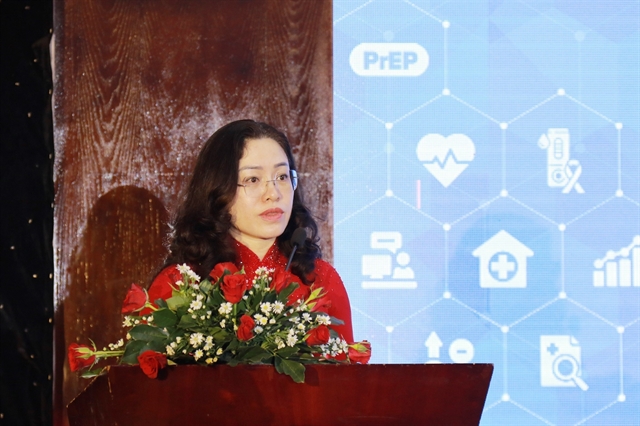 Opinion
Opinion


|
| A person living with HIV in Quảng Ngãi Province can get medications and consultation at a specialised medical station on a regular basis. — VNA/VNS Photo Đinh Hương |
Phan Thị Thu Hương, head of the Vietnam Administration of HIV/AIDS Control under the Ministry of Health, speaks to Vietnam News Agency about changes in the HIV/AIDS patterns and prevention models being applied.
What is the current HIV/AIDS situation in Việt Nam?
In Việt Nam, it is estimated that there are currently about 250,000 people living with HIV. As of September 2023, Việt Nam has recorded 100 per cent of provinces and cities with people infected with HIV/AIDS.
HIV-infected people detected and reported are mostly from the southeast region, accounting for 38.67 per cent and the Cửu Long (Mekong Delta) region, making up about 19.87 per cent.
In the first nine months of 2023, Việt Nam recorded 10,219 new HIV-positive cases and 1,126 deaths. Among people newly discovered to be infected with HIV, 84.5 per cent are men, mainly from 16-29 years old, accounting for 47.3 per cent and from 30 - 39 years old, accounting for 28.2 per cent.
The main source of transmission is unsafe sex (accounting for 75.1 per cent). The rate of HIV infection among men who have sex with men (MSM) accounts for 49.2 per cent.
The pattern of HIV infection has changed since 2010. Among newly discovered HIV-infected people, the proportion of those infected with HIV through blood decreased from 47.5 per cent in 2010 to 6.4 per cent in 2023.
The prevalence of HIV transmission through sexual contact has become the main transmission route, increasing from 47.5 per cent in 2010 to 84.4 per cent in 2022 and 75.1 per cent in 2023.
The HIV infection rate among MSM tends to increase recently and is predicted to be on an upward trend in the future.
HIV prevalence among MSM in HIV sentinel surveillance increased from 7.4 per cent in 2016 to 12.5 per cent in 2022.
Recent research shows that transgender women are also one of the groups warned of HIV infection risks with the infection rate tending to increase.
According to Việt Nam’s HIV forecast statistics in 2022, MSM is the main group highly exposed to HIV infection risks.
Statistics show new HIV infections are mostly from southern localities and there is an increasing infection trend in the localities that did not record many cases earlier. What are the main reasons for this?
Donors used to provide support of up to 80 per cent of the budget for HIV prevention, but since 2015, when the supportive sources started to withdraw from Việt Nam, we must take advantage of flexible models to connect provinces and cities that are not hot spots of infection so that people at risk can connect on their own.
The HIV infection risk exists in many places, not just in hot spots. Emerging disease areas like Kiên Giang, Đồng Nai, Cần Thơ, An Giang were detected thanks to trans-provincial connection models.
We have discovered target groups that have had difficulty accessing services, do not have enough confidence, or discriminate against themselves. Community groups introduced new models and new approaches to each other, for example, self-testing using fingertip blood or oral fluid. They can self-transfer samples to a laboratory for results.
People with the disease find it easy to connect and then introduce to each other new models of treatment and exposure treatment for people at risk of HIV to promptly prevent the infection.
This helps detect new cases and prevent people at risk of HIV infection. Because only people at high risk get tested and when tested, people with the disease can be screened and immediately advised on treatment with ARV drugs.
This is an effective model because after only two to six months of treatment, those newly discovered people will have a very low, stable viral load, and no longer carry transmission source.
For uninfected people who are advised to use pre-exposure prophylaxis (PrEP), it can control up to 98 per cent of the risk of HIV infection through sexual contact.
How do you assess the role of community groups in HIV prevention and control?
Besides the involvement of ministries and sectors from central to local levels, the private sector and social organisations, especially target community groups play important roles.
Those include people infected with HIV and people with high-risk behaviours for HIV infection such as men who have sex with men, transgender women, drug users, sex workers and sexual partners of the above groups.
In HIV prevention and control, if we do not rely on community models but only on available medical resources, we will not be successful.
Việt Nam only has five years left to end the AIDS epidemic. Without stronger participation from the community, without people connecting with high-risk groups, it will be difficult for us to control the disease.
The national strategy to end the AIDS epidemic by 2030 also clearly points out new directions in accessing HIV testing services: Expanding and diversifying types of HIV testing counselling and promoting community-based HIV testing and self-testing. Community-based groups have helped maximise HIV testing and counselling services in the community.
Through HIV self-testing products through community-based groups and other channels, testing for new infections has been implemented in 35 provinces/cities across the country. The community has been called upon to actively participate in finding HIV cases, calling on people with HIV and people with high-risk behaviours to participate in providing special HIV/AIDS prevention and control services. especially HIV testing counselling.
This helps reach more people with high-risk behaviours because services provided by people in the same situation will greatly reduce barriers to stigma and self-stigma of people in the community.
In 2023, we have chosen “Creative Community – Determination to End the AIDS Epidemic by 2030” as the theme of HIV/AIDS Prevention Month. We have also chosen community groups as a key to quickly expanding services, launching initiatives and service-connecting applications.
This can help detect many hidden infected people in the community and better prevent the epidemic.

|
| Phan Thị Thu Hương, head of Vietnam Administration of HIV/AIDS Control under the Ministry of Health.— VNA/VNS Photo Đinh Hằng |
What solutions need to be implemented in the future to maintain sustainable ARV treatment and ensure sustainability in HIV/AIDS epidemic prevention?
In the future, we need to focus on implementing connecting case finding – HIV testing – HIV treatment facilities.
It is necessary to mobilise the participation of community groups and expand the network of HIV testing facilities and HIV treatment facilities at grassroots health levels that are qualified to provide HIV treatment services through health insurance including both public and non-public medical facilities.
It is necessary to ensure the source of ARV drugs is covered by the health insurance source and increase the proportion of patients with health insurance cards to help them access HIV examination and treatment services from the health insurance fund.
Provinces and cities need to be guided to proactively provide on-site HIV detection and viral load testing services, with medical facilities proactively signing contracts with units that can provide these tests through health insurance.
The capacity of medical staff to treat latent tuberculosis, co-infected diseases, and non-communicable diseases also needs to be improved, helping treatment facilities provide other medical examination and treatment services right at the HIV treatment facility.
We also need to expand PrEP treatment to provinces that do not receive support from projects for high-risk groups to ensure the best prevention for people not at risk. — VNS




